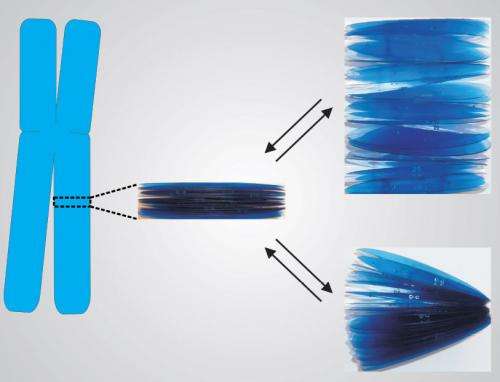Physical reason for chromosome shape discovered

Researchers from the Universitat Autònoma de Barcelona have determined why metaphase chromosomes have their characteristic elongated cylindrical shape. The results show that this morphology is related to the chromosome's self-organizing structure.
This work gives a solution to a fundamental question in structural biology: Why do metaphase chromosomes have their characteristic elongated cylindrical shape? The proposed solution is consistent with the structure of metaphase chromatin and with the nanomechanical properties of chromatin and chromosomes. It is a research at the interface between biology (higher order chromatin structure) and physical sciences (supramolecular structures and nanomaterials). This approach goes beyond the capabilities of current structural biology based on X-ray crystallography, because it allows the study of an enormous supramolecular assembly that cannot be crystallized. The work has been published in the Journal of the Royal Society Interface.
In the cell nucleus, genomic DNA molecules are associated with histone proteins and form long chromatin filaments containing many nucleosomes. Previous microscopy studies performed by researchers at the Chromatin Laboratory directed by professor Joan-Ramon Daban (Biosciences Unit of the Department of Biochemistry and Molecular Biology, UAB) showed that, during cell division, chromatin filaments are folded into multilayer planar structures. This discovery led to the thin-plate model in which it was proposed that condensed chromosomes are formed by many stacked layers of chromatin oriented perpendicular to the chromosome axis.
The measurements performed by professor Daban show that chromosomes of different animal and plant species exhibit great differences in size (which are dependent on the amount of DNA that they contain), but in all cases chromosomes are elongated cylinders that have relatively similar shape proportions (the length to diameter ratio is approximately 13). This study demonstrates that it is possible to explain this morphology by considering that chromosomes are self-organizing supramolecular structures formed by stacked layers of planar chromatin having different nucleosome-nucleosome interaction energies in different regions. The nucleosomes in the periphery of the chromosome are less stabilized by the attractive interactions with other nucleosomes and this generates a surface potential that destabilizes the structure. Chromosomes are smooth cylinders because this morphology has a lower surface energy than structures having irregular surfaces. The symmetry breaking produced by the different values of the surface energies in the telomeres and in the lateral surface explains the elongated structure of the chromosomes.
The results obtained by other authors in nanomechanical studies of chromatin and chromosome stretching have been used to test the proposed supramolecular structure. It is demonstrated quantitatively that internucleosome interactions between chromatin layers can justify the work required for elastic chromosome stretching. Chromosomes can be considered as hydrogels with a lamellar liquid crystal organization. These hydrogels have outstanding elastic properties because, in addition to the covalent bonds of the DNA backbone, they have attractive ionic interactions between nucleosomes that can be regenerated when the chromosome suffers a deformation. This self-healing capacity has been observed in nanotechnology studies of other hydrogels stabilized by ionic interactions. In the cell, this may be useful for the maintenance of chromosome integrity during mitosis.
More information: Joan-Ramon Daban (2014) The energy components of stacked chromatin layers explain the morphology, dimensions, and mechanical properties of metaphase chromosomes. J. R. Soc. Interface 11: 20131043. dx.doi.org/10.1098/rsif.2013.1043
Journal information: Journal of the Royal Society Interface
Provided by Universitat Autonoma de Barcelona

















